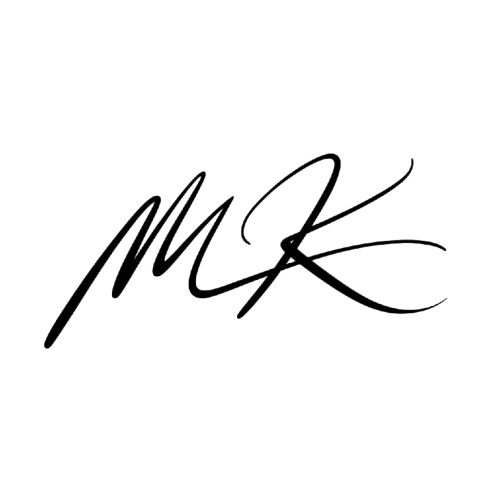Share
This is what we will cover in the blog post
Part 1: Introduction: Why Most Interviews Fail Today
Part 2: Bad vs. Good Interview Questions
Part 3: How to prepare before the Interview: Check what the candidate submitted
Part 4: During the interview: Ask in-depth Questions
Part 5: When to Layer in General Questions
Part 6: Common Mistakes to Avoid when Interviewing Applicants
Part 7: How to practically interview applicants while hiring through Workscreen.io
Part 8: Final thoughts
Part 1: Introduction: Why Most Interviews Fail Today
Interviewing candidates the right way is the key to hiring top talent. But too often, hiring managers and founders rely on structured questions that don’t actually help them identify the best person for the job. If you can relate, this blog post is for you.
Here’s the problem: candidates today aren’t just showing up to interviews—they’re showing up armed. AI interview tools like Parakeet AI, Bezy AI, and AI Apply are designed to provide interview answers on the fly and provide live guidance during interviews.
Here is evidence from candidates looking for/using such tools.
The first screenshot shows someone asking for help with an AI interview assistant.

Below is one of the responses they got from a candidate who has actually used such a tool

Such experiences reveal that if you’re a recruiter still asking questions that AI can answer, you’re putting yourself at a disadvantage because candidates already have loopholes to cheat the system. This guide will help you identify such red flags and assist you in asking the right questions that someone cannot fake, regardless of the role you are hiring for.
Part 2: Bad vs. Good Interview Questions
To make it clearer, let’s start with examples of bad interview questions you may be asking:
Q1: “Where do you see yourself in five years?”
Q2: “Why do you want to work at our company?”
On the surface, these seem like reasonable questions. But they’re not. These are exactly the kinds of questions AI tools are trained to answer instantly and convincingly. You’ll likely get well-worded but totally robotic responses. These questions offer no insight into the candidate’s real thinking, and they cannot help you verify authenticity. They don’t tap into memory/history/lived experiences or emotions/feelings. If you have been asking such questions, it may be the reason why you are ending up with the wrong hires.
So, what is the right way to interview someone?
We will use the same examples as above to show you the right way to phrase them and explain why they are better.
Q1: Instead of asking, “Where do you see yourself in five years?” Ask this
“Think back to the start of your career. What’s one belief or goal you had then that’s changed—and what experience shifted it for you?”
Why is this question now better?
It pulls the candidate into personal history rather than prompting future projections, something that an AI tool struggles with. It also triggers reflection and vulnerability. The question also reveals self-awareness and emotional intelligence, and uncovers real values, not just rehearsed ambitions.
Q2: Let’s look at the second one: Instead of asking, “Why do you want to work at our company?” ask this:
“Where did you come across our job post? What was the process of applying? When you came across it, what specifically caught your attention? What made you pause and feel like, ‘I should look into this one’?”
Why is this a better way of asking the question?
It tests for authenticity. If a candidate is using an AI interview assistant, it would not know where exactly you posted the job. It’s also about invoking a memory and needs specifics. If a candidate is bluffing or is using an AI assistant tool, they’ll likely fumble and give you inaccurate or very vague answers. This makes it easy for you to distinguish a genuine applicant from one who is trying to cheat the system.
And the truth is that generic questions lead to generic hires. If you want to hire right, ask questions rooted in memory, emotions, or lived experience—because AI doesn’t have any of those.
Sign up with Workscreen today since it helps you eliminate low-effort applicants, including those who use AI Tools to apply, copy-paste answers, or rely on "one-click apply." This way, you focus only on genuine, committed, and high-quality candidates—helping you avoid costly hiring mistakes.
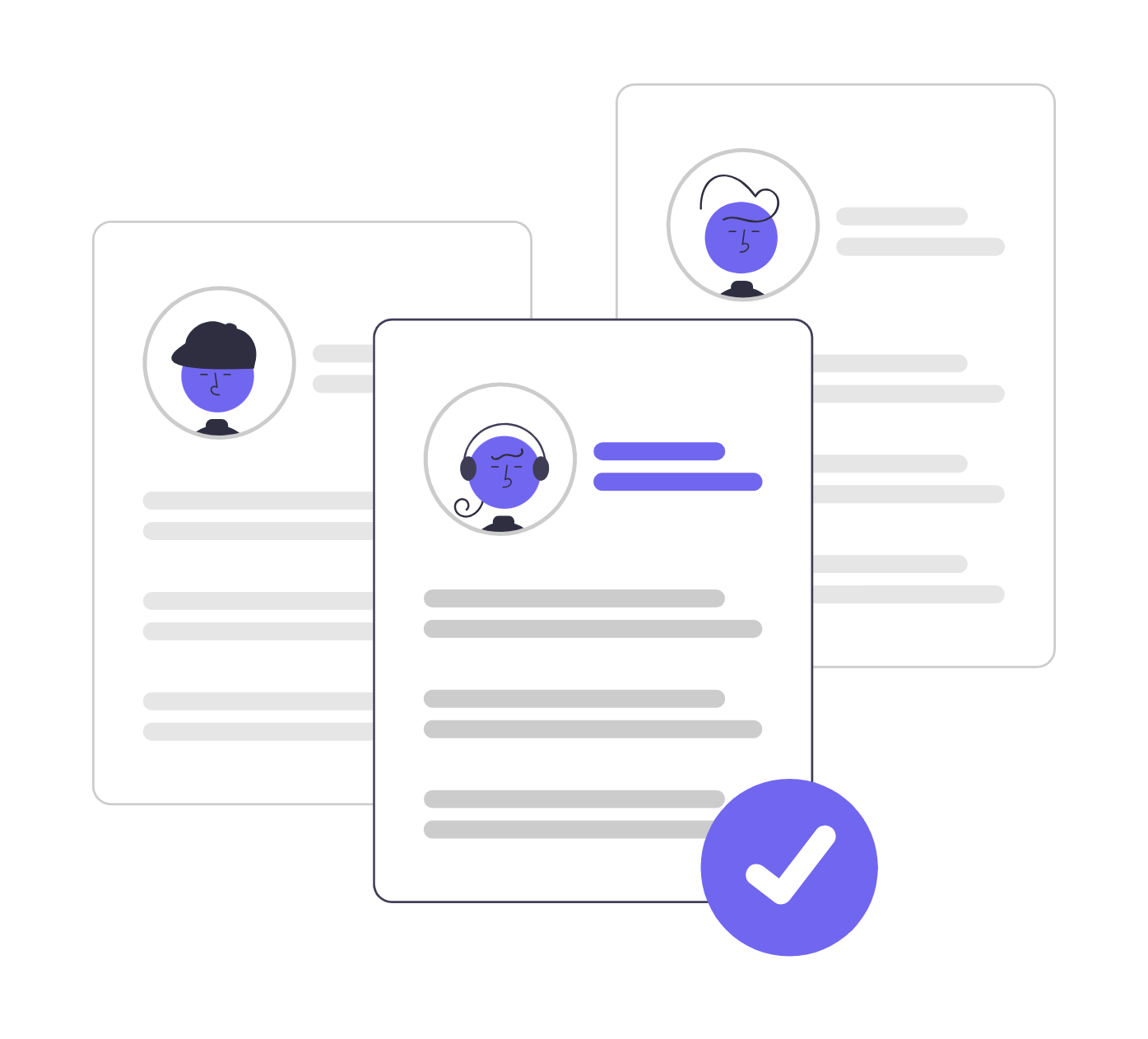
Part 3: How to prepare before the Interview: Check what the candidate submitted
Before the interview, take time to review everything the candidate submitted—whether it’s a CV, résumé, responses to pre-screening questions, or a portfolio, depending on the role. Doing this allows you to craft follow-up questions that go beyond surface-level answers. It also helps you dig deeper, spot inconsistencies, and assess whether the candidate is truly genuine.
For instance, if a candidate wrote in their resume that they led a team through a tough product launch, you can come up with follow-up questions like this:
- “Tell me about a day during that product launch that felt especially hard. What was happening? And how did you handle the challenges that day?”
- “What do you remember most about how the team handled the pressure?”
- “If you could go back and change one decision you made during that period, what would it be and why?”
Even a small section of a candidate’s résumé, CV, or response to prescreening questions can spark insightful, in-depth questions—questions that only someone with real, lived experience can answer. These follow-up questions matter because they help you evaluate how the candidate thinks, how they handle pressure, and whether they truly did what they claimed. If someone is relying on an AI interview tool, they’ll likely stumble or hesitate when faced with these types of follow-up questions.
Part 4: During the interview: Ask in-depth Questions
AI tools can mimic language, but they can’t fake memories. They don’t have emotions or history. They don’t know how it felt to mess up a big project. Or what someone’s manager said to them in a tough moment. Or why they clicked your job post instead of the ten others. If you want real answers, ask real human questions. Questions that evoke memories/history, emotions/feelings. You should ask focused, practical questions during the interview — the kind that reveal real thinking.
Here are examples of good questions that you can ask in an interview when hiring for any role.
- “What’s the most difficult task you’ve worked on?? Walk me through that day. Were you calm and composed? Did you panic, or did you feel frustrated? What task was it? How exactly did you handle the task? What did your supervisor say regarding your output?”
- “Tell me about the last time you got negative feedback from your employer or a client. What happened? How did you handle this feedback? What did you learn from it?”
- “When did you last disagree with a teammate? What was the disagreement about? How did you handle the situation?”
- “When did you realize you were good at what you do, and how did you realize it?”
- “Tell me about a time you had to learn something fast. What exactly did you have to learn, and what approach did you take?”
- “What’s a moment at work that made you emotional? What had happened? How did you handle the situation?”
- “Tell me about your first week at your last job. How was it? Was it raining or chilly? Were you nervous? Did you encounter any challenges? How did you handle them?”
- “Describe a decision you made under pressure. What exactly happened and what did you learn from the situation?”
As you can see from the examples above, each question is followed by in-depth questions. These are difficult to fake, because only someone who’s actually lived the experience can answer them clearly.
Part 5: When to Layer in General Questions
Once you’ve confirmed someone’s genuine experience and thinking process, and you are thinking of hiring them, you can move into more straightforward questions to understand them better. Think of the general questions as final checklist items when conducting an interview, not the foundation of your hiring decision.
Some of the general questions you can ask at this point are related to the following:
Availability and Start Date: To assess this, you can now ask the following:
- “What’s your earliest possible start date, and do you have any scheduling constraints we should be aware of?”
- “Are you currently working or transitioning from another role? What kind of notice period would you need to give?”
- “Do you have any upcoming commitments (travel, exams, major events) that might affect your availability in the next 2–3 months?”
Asking these questions helps you know when the candidate can realistically begin working if you choose to hire them. Their answers can also help you gauge whether their timeline aligns with your needs. If someone is vague about availability or keeps changing timelines, it could signal indecision or a lack of interest, as clear, proactive candidates tend to have a plan.
Familiarity with Specific Tools or Tech: To assess this, you can ask the following:
- “Which tools do you currently use most often in your day-to-day work?”
- “Can you describe a time when you had to quickly learn a new tool or platform? How did you go about it?”
- “Are there any tools or systems you’re particularly confident in or ones you’d like more exposure to?”
These questions are good to ask at the end of the interview because, in most industries, tools are the building blocks of productivity. Find out which tools a candidate is comfortable with and whether they can easily learn new tools or adapt to change.
Part 6: The most Common Mistake to Avoid when interviewing applicants
Avoid closed-ended interview questions.
Questions that can be answered with a simple “yes” or “no” rarely reveal the qualities that matter most—like decision-making, communication style, thought process, emotional intelligence, or cultural fit. These types of questions limit your insight. Worse, they often lead to robotic, rehearsed responses—especially now that AI interview tools like Parakeet AI can instantly generate “perfect” answers.
To clarify this, here is a comparison table that illustrates examples of closed-ended questions, their shortcomings, and better alternatives you can use instead.
Closed-ended interview questions you should avoid asking | Why is it wrong to ask such a question in an interview? | An open-ended alternative to the question | Why the open-ended alternative is good |
“Are you good at multitasking?” | Most people will say “yes” to sound competent. But it tells you nothing about how they manage tasks or whether they’re effective. | “Tell me about a time when you had multiple deadlines to meet simultaneously. How did you prioritize the tasks? What approach did you use to deliver the tasks before deadlines?” | This forces the candidate to recall a real-life experience, revealing their decision-making, planning, and time management skills under real-world pressure. It taps into history. Genuine answers will include specifics, context, and reflection—things AI tools and unqualified candidates struggle with. |
“Can you work well under pressure?” | This encourages candidates to give a yes answer. Anyone can say yes, but that doesn’t mean they’ve proven it in a real situation. | “Describe a high-pressure situation you faced at work. What was going on, and how did you handle it? Did you talk to your supervisor about it? What was the response?” | This question is powerful because it does more than test for composure under stress—it provides a comprehensive view of the candidate’s behavior, communication style, and decision-making abilities under pressure. It makes it difficult for candidates to give polished, surface-level answers. If someone can’t describe the emotions they felt, the people involved, and a specific example with context, it’s a red flag. |
“Have you ever worked in a team?” | Since most jobs involve teamwork, a candidate is likely to answer yes. The problem is that this answer doesn’t tell you how they collaborated, resolved conflicts, or added value. | “Tell me about the last team project you worked on. What was your role, and how did you contribute?” | It helps you assess a candidate’s collaboration, accountability, and situational awareness within a team. It reveals real-time experience and tests for role clarity. |
“Would you say you’re detail-oriented?” | Most candidates will say yes. But without evidence or examples, the answer is meaningless. | “What’s a time when catching a small detail made a big difference in your work? Describe the scenario, and what detail did you catch? What was the impact?” | These question forces the candidate to recall a specific situation and connect it to a tangible outcome. That’s hard to fake. |
“Are you passionate about this industry?” | Asking the question like that will just lead to a yes answer, which tells you nothing about what draws them to the line of work. | “What drew you to this industry or role in the first place, and what’s kept you interested over time?” | This invites a story and helps you gauge authenticity. If a person is genuine, you’ll hear about real moments, internal motivations, and long-term alignment—not just lip service. |
Part 7: How to Practically Interview Applicants when hiring through WorkScreen
Now that you understand how to interview applicants effectively, let’s show you how to put that into action using WorkScreen.io, our hiring software built to make the hiring process faster, smarter, and more effective. WorkScreen helps you quickly identify top talent and filter out low-effort applicants—saving you time and effort and reducing the risk of bad hires.
Getting started is simple:
Just sign up, create a job post, and let WorkScreen guide candidates through the evaluation process automatically.
Get started with Workscreen today and quickly identify your most promising candidates. WorkScreen automatically evaluates, scores, and ranks applicants on a performance-based leaderboard—making it easy to spot top talent, save time, and make smarter, data-driven hiring decisions.

Part 7: How to Practically Interview Applicants when hiring through WorkScreen
Once candidates complete the evaluation process, head to your dashboard—it will look something like this:
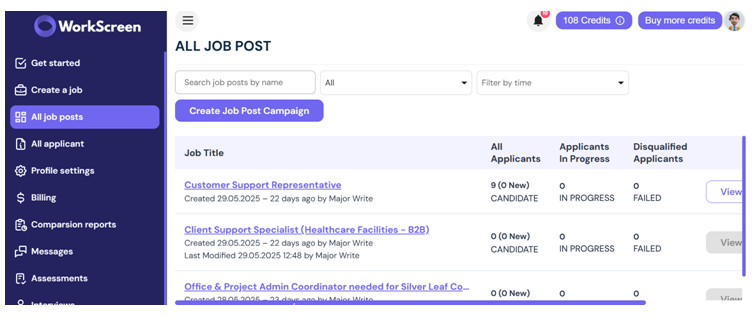
Click on all job posts as shown below.
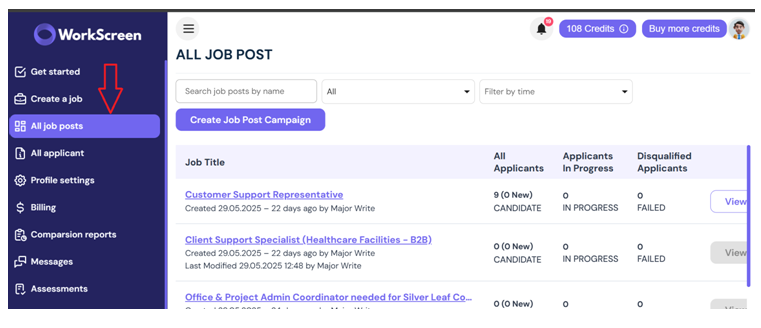
Navigate to the job role you’re hiring for. In this example, let’s say you’re hiring a Customer Support Representative—simply click on that specific job title, as shown below.
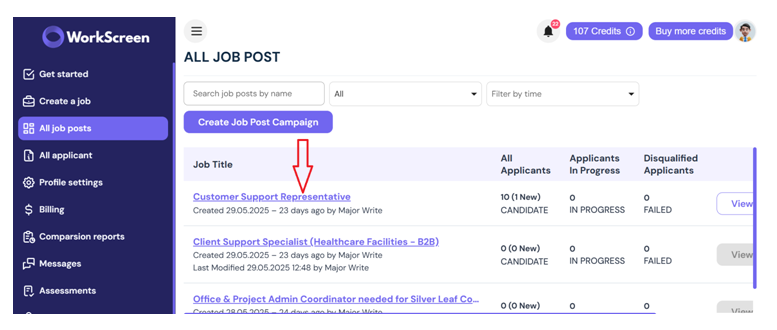
And then click on View Leaderboard
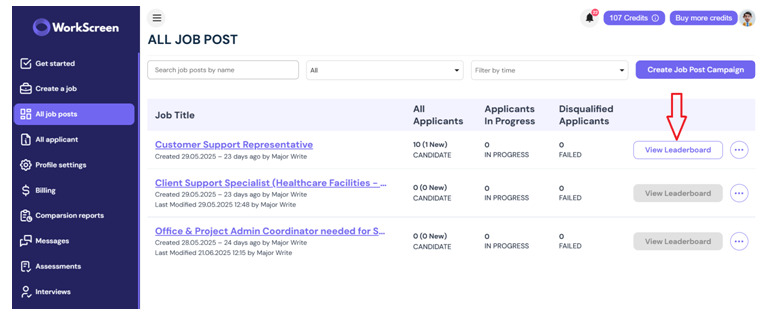
Once you click on leaderboard, the next page will appear like this
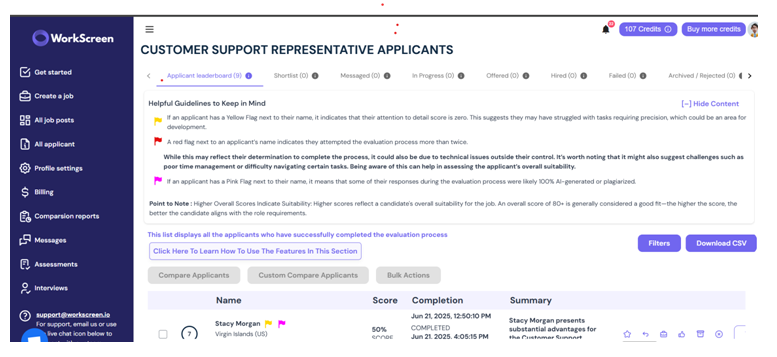
Scroll down to the section labelled name
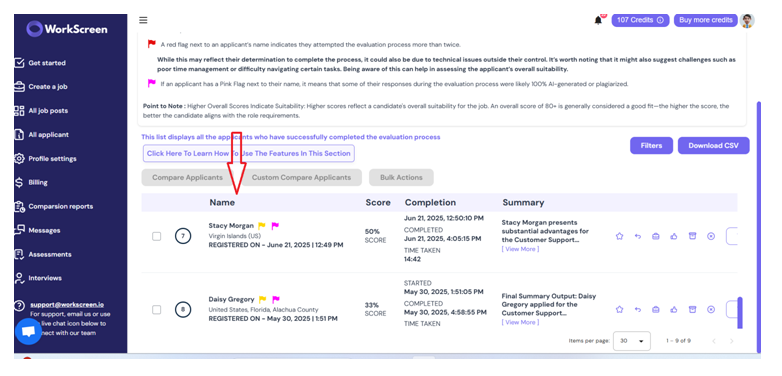
You’ll see a list of candidates who have applied for your job. To review a candidate’s responses, simply choose a candidate and click “View Details” next to their name. For example, if you want to review Stacy Morgan’s answers to the evaluation questions, click “View Details” beside her name, as shown below.

Once you do, this page will be displayed
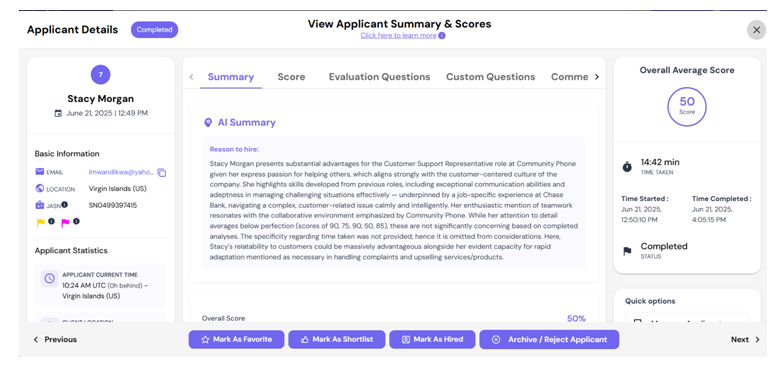
Next, click on Evaluation questions as shown below
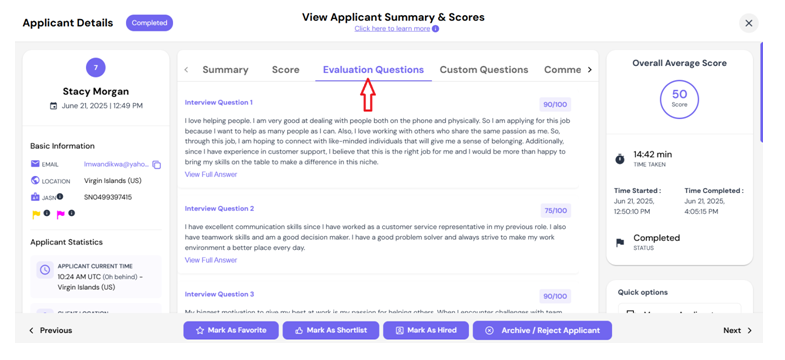
You’ll now see a summary of the candidate’s responses, as shown below.
It’s time to go through each question individually so you can better understand the candidate and use their answers to craft meaningful, in-depth interview questions.
For each response, click “View Full Answer” as shown below.
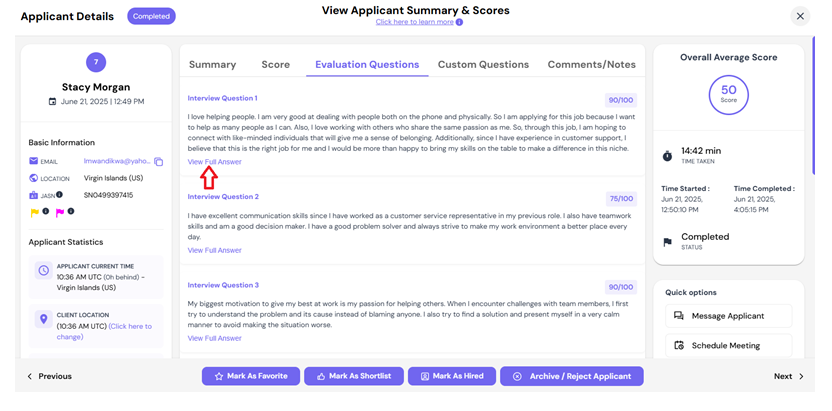
The next page will look like this, clearly showing the question the candidate was asked and the answer they provided.
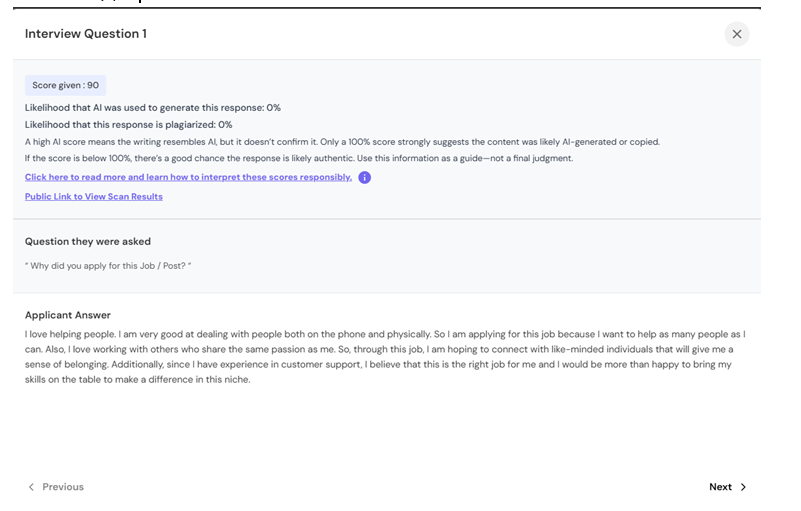
Based on the applicant’s answer, you can now craft in-depth, human-centric interview questions designed to test for authenticity. One of the advantages of hiring through WorkScreen is that candidates don’t receive a copy of their responses after completing the evaluation. This gives you a unique edge—you can use their original answers to formulate thoughtful follow-up questions for the interview.
To illustrate this clearly, let’s look at a table of good vs. bad interview questions based on the applicant’s response above, along with explanations of what makes each question effective—or not.
Good follow-up question | Why is it good | Bad follow-up question | Why it is bad |
“In your application, you mentioned that you are very passionate about this one thing. What was it?” | This helps you test if they remember what they wrote in the evaluation and if it is indeed true. If a candidate has true passion for helping others, they will clearly answer this. But if they sound confused, it is probably a lie. | Going straight to asking them this, “Why do you like helping people?” | It is too vague and does not help you verify authenticity since it does not trigger any memory. |
“How did you first discover that you were passionate about helping people? What was happening? What day was it?” | It revolves around history/origin and is not based on opinion. It triggers a memory not a concept and it defeats rehearsed responses. | “How do you handle difficult customers?” | This is a generic question that can easily be answered by a candidate using an AI interview assistant |
“Can you take me back to a moment when helping someone truly impacted you? Explain what was happening, how you helped them and how you felt by helping them.” | This uncovers emotional memory and real motivation | “What are your strengths in customer service?” | It encourages a rehearsed response with no real story behind it to test for auntheticity |
“Have you ever come across a rude or unreasonable person on call? How did you handle such?” | It revolves around history and invokes story telling. | “What does team work mean to you?” | It triggers a generic definition, not a lived experience. |
“Was there a time when helping someone didn’t go the way you hoped? What exactly happened? How did that affect you?” | It demands a personal story, not a generic answer. It triggers memory and emotion. | What are your strengths in customer service? | It invites generic, rehearsed answers. It also lacks depth and context. |
Once you’ve finished crafting strong, in-depth questions based on the first answer, click “Next” to view the candidate’s response to the second evaluation question, as shown below.
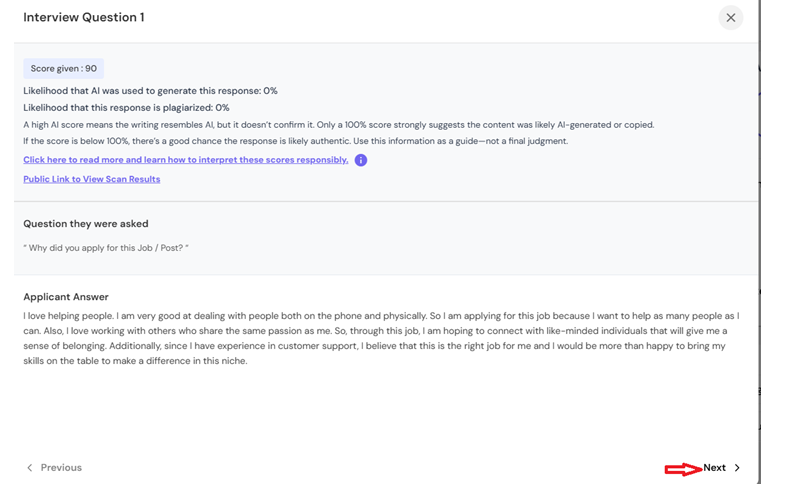
The next question will appear like this.
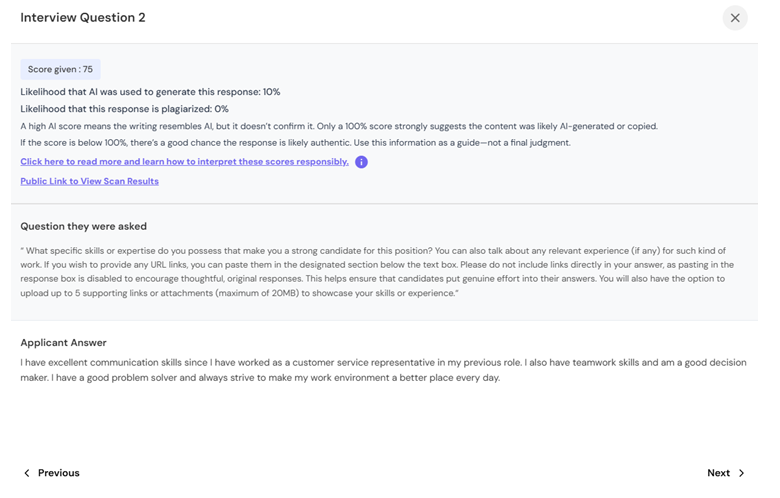
Just like you did with the first applicant response, use this second answer to create in-depth, human-centric interview questions.
Now, let’s explore examples of good vs. bad follow-up questions based on this response.
Good follow-up question | Why it is good | Bad follow up question | Why it is bad |
“Can you tell me about a specific situation where your communication skills helped de-escalate a tense situation with a customer?” | It requires a real memory, not a buzzword. You get a story, emotional context, and outcome—not just a claim. | “How would you describe your decision-making style?” | It sounds smart, but leads to empty buzzwords like “logical” or “strategic.” It’s not grounded in memory. |
“Tell me about a time when you had to make a difficult decision quickly. What was at stake, and what did you learn from it?” | It requires emotional judgment and lived experience. This question is great for assessing real decision-making skills. | “Are you comfortable working in a fast-paced environment?” | Everyone says yes—even if it’s not true. So this question cannot tell you anything about he candidate. |
“Think back to a moment when you solved a tough customer problem creatively. What did you do, and how did the customer respond?” | It triggers storytelling and helps reveal how they think under pressure and whether they care about outcomes. | “What kind of work environment do you like?” | It’s vague and subjective. Candidates will just tell you what they think you want to hear. |
“Tell me about a time when you took initiative to improve something at work that wasn’t part of your job description. What motivated you?” | This goes beyond surface-level claims and forces the candidate to explain how exactly they have ever made their work environment a better place. | “What makes you a good communicator?” | This is generic. Encourages empty self-praise like “I’m clear and concise.” There is no story to assess whether it is true or not. |
“What’s one customer interaction from your last role that you still think about today—good or bad? What happened, and why did it stick with you?” | It requires a real memory, not just a recap of the job title or duties. | “What type of people do you work best with?” | It encourages surface-level personality talk. It doesn’t reveal how they adapt or resolve conflict. |
Once you’ve finished crafting the right questions from their second response, click “Next” to proceed to Interview Question 3, as shown below.
This action will direct you to interview question 3, which looks something like this.

Just like with Interview Questions 1 and 2, use the applicant’s response here to develop in-depth, human-centric interview questions.
Now, let’s look at examples of good vs. bad questions you can craft from this answer.
Good in-depth question | Why its good | Bad question | Why it is bad |
“Can you walk me through a specific time when you had a disagreement with a team member—what caused it, and how did you handle it?” | Requires memory recall. | “Do you get along with your coworkers?” | This is too vague. It invites a yes/no answer that tells you nothing about the candidate. |
“What’s a moment at work when you felt especially motivated or proud—what happened that day?” | Focuses on a lived emotional experience. It shows what they value and what motivates them deeply. | “How do you make sure your passion doesn’t burn out?” | Though this sounds deep, it’s vague and hard to answer meaningfully without context. |
“Has there ever been a time when staying calm in a conflict was difficult for you? What did you do?” | This invokes storytelling and uncovers growth moments and real tension. | “Would you say you’re emotionally intelligent?” | The candidate will probably say yes but this question doesn’t test or challenge that claim. |
“What’s a challenge you faced on a team that didn’t go as planned—and how did that impact your motivation?” | It digs deeper into memory and forces them to explain more | “What do you think makes a positive team environment?” | You’ll get vague answers like “respect” or “good communication.” No proof. |
“What’s something a colleague once said to you—positive or critical—that really stuck with you?” | This encourages emotional memory. You’ll learn how they’re perceived and how deeply they reflect on interpersonal feedback. | “How do you avoid team conflict in general?” | This is a generic question that will only lead to generic answer. |
Once you’ve finished formulating follow-up questions from all of the applicant’s responses, close the interview question tab by clicking the “X” icon, as shown below.
Now, Let’s Look at Custom Questions
WorkScreen gives you the option to add custom questions when creating a job post. Custom questions are role-specific questions you may have added. They differ from the standard evaluation questions that candidates undergo during the evaluation process. To clarify, let’s say you’re hiring a Customer Support Representative—here are some examples of custom questions you might include during job post creation:
- You’ll be expected to handle multiple customer chats or calls at once—are you good at multitasking?
- Our team is remote. Are you okay working independently?
- Do you feel confident in upselling products to customers?
- How well do you know how to use tools like Hubspot?
- Would you be willing to learn new tools if needed?
If you included any custom questions during job post creation, they will appear in the section labeled “Custom Questions.” You will access this section immediately you click on the X icon we mentioned above. The Custom Questions tab looks like this:
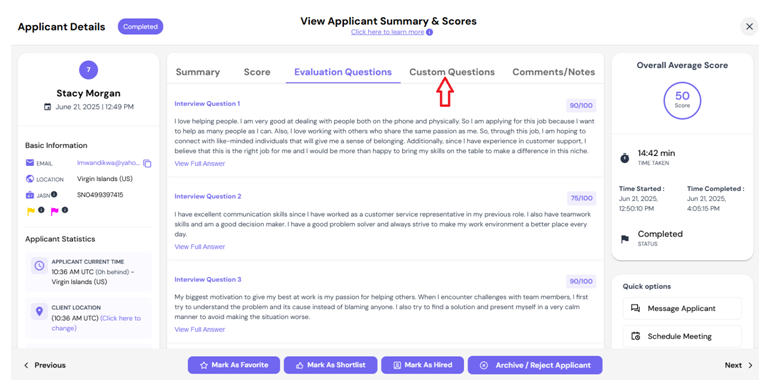
Review the custom questions you included and examine how the applicant responded. Then, use the same approach we covered earlier to craft in-depth, human-centric follow-up questions.
What If You Requested a Video Introduction?
One unique feature WorkScreen offers is the ability to request a short video introduction from candidates during the job post creation process. If you selected this option, a link to the candidate’s video will appear under the “Custom Questions section.”
Simply click the video link to watch the candidate’s introduction. Pay attention to how they present themselves, and use their responses to craft follow-up questions that help you verify authenticity and communication skills.
Final Thoughts
The key to spotting genuine candidates—and filtering out low-effort ones trying to game the system—lies in how you interview them. It all starts with the questions you ask. As you prepare for your next interview, focus on the in-depth, human-centered questions we’ve discussed—and avoid generic questions that lead to robotic answers. That’s how you avoid costly hiring mistakes and make smarter hiring decisions.
Now, remember to hire with Workscreen.io since it streamlines your hiring process. Workscreen helps you
- Quickly identify your most promising candidates. WorkScreen automatically evaluates, scores, and ranks applicants on a performance-based leaderboard—making it easy to spot top talent, save time, and make smarter, data-driven hiring decisions.
- Eliminate low-effort applicants—including those who use AITools to apply, copy-paste answers, or rely on “one-click apply.” This way, you focus only on genuine, committed, and high-quality candidates—helping you avoid costly hiring mistakes.
- Administer one-click skill tests — so you can assess real-world ability, move beyond resumes, and hire with confidence.
- Hire holistically based on real-world skills, adaptability, attention to detail, strong time management , problem-solving, and teamwork, instead of hiring solely based on experience, resumes, and technical qualifications.
Sign up with Workscreen today and hire easily, right, and fast! It helps you hire holistically based on real-world skills, adaptability, attention to detail, strong time management , problem-solving, and teamwork, instead of hiring solely based on experience, resumes, and technical qualifications.


